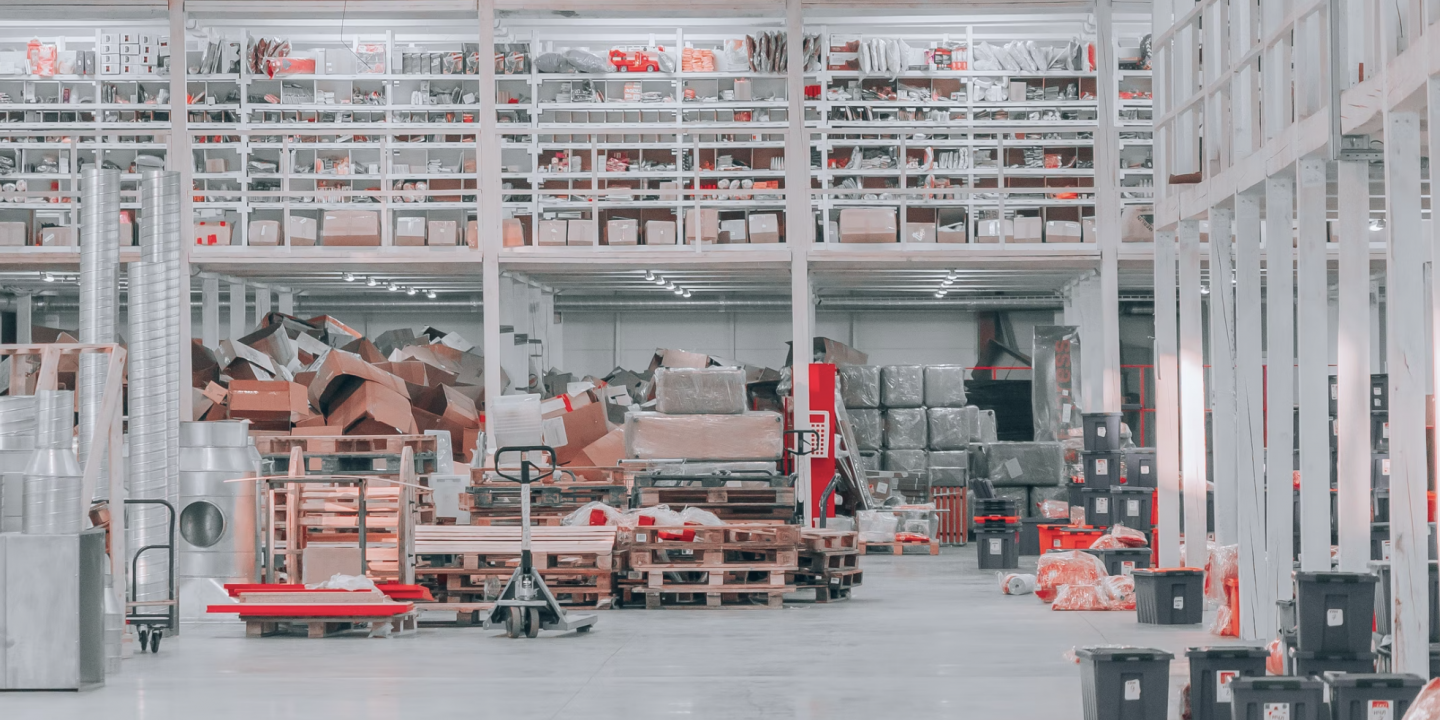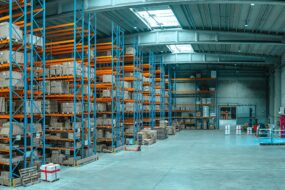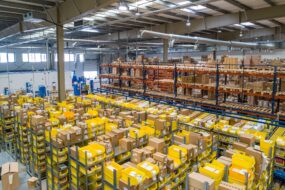Contents

Warehousing practices have come a long way in the past few decades. Today, smart warehousing involves computers and new technology doing many of the warehouse practices that used to be done by humans.
Using these new technologies for warehouse practices improves efficiency, boosts productivity, and cuts costs.
What Is Smart Warehousing?
Smart warehousing involves the use of technology, robotics, and automation to improve logistics and operations. Various technologies might be involved in smart warehousing, such as artificial intelligence and robots. By using these technologies, smart warehousing can improve fulfillment accuracy, stock products faster, fulfill orders more efficiently, and boost productivity.
How Does a Smart Warehouse Compare to a Traditional Warehouse?
In a traditional warehouse, workers move around the facility with packing slips, pick products, and move them to a packing area or loading dock. In a smart warehouse, many of these tasks are automated.
First, the system confirms the items are in stock. Then, orders are often processed automatically. Robotic carts may then pick the items. Robotic technology may be involved in some aspects of packaging and shipping the items, but humans are generally involved in this step as well.
Benefits of Smart Warehousing
There are many benefits of smart warehousing, and they all have positive effects on a company’s bottom line. Here are a few of them:
Better Inventory Management
When processes are automated, you can easily track inventory, including how many units are on the shelves and how many are being sent out. Tech-enabled systems take the tedious paperwork out of the equation and handle the data management for you.
With the right technology, you can manage inventory across multiple warehouses in one central inventory management system. These systems can easily track which SKUs are responsible for the most sales, how low inventory affects order fulfillment, what percentage of orders are delayed versus on time, and which items are not moving and resulting in high storage costs.
A smart warehouse will have an excellent inventory management system that tracks all this data. You can then make smart decisions on strategy shifts when you have this information handy.
Faster Order Fulfillment
Smart warehousing processes allow for much faster order fulfillment and shipments, meaning customers get their products much faster. The picking process goes significantly faster as robots know exactly where to locate items and packages are assembled more quickly.
Because fewer humans are involved in the order fulfillment process, things just move faster. Robots can work around the clock to fulfill orders, shortening the time it takes your products to get to your customers considerably.
Fewer Errors
There are many steps in the order fulfillment process, and errors can happen at any point in that process. Humans make mistakes while stocking, managing inventory, picking, packing, and shipping products.
By automating some of these steps, errors are significantly reduced as are labor costs. When errors become less frequent, customer satisfaction rates increase.
Lower Operating Costs
Smart warehousing is easier on employees. Automation and artificial intelligence take some burden off employees, allowing them to focus on more critical tasks. This reduces labor costs, which can translate into lower prices for customers and better profitability for businesses.
Better Customer Service
Smart warehousing results in many positives that make for better customer service overall. With faster shipping times, fewer fulfillment errors, and cost savings that enable lower prices, customers are just happier. This boosts your customer service overall.
Fewer Returns
Automating some of the picking and packing process means fewer errors, and this results in fewer returns. Improved accuracy is one of the major benefits of smart warehousing. Again, this translates into high rates of customer satisfaction.
Smart warehousing can also involve a digitized and detailed returns management system. If returns are managed well, customers get refunds or replacements more quickly and items get back on the shelves sooner.
Greater Transparency
With smart warehousing, a lot of data is collected, and this information can be easily viewed and analyzed. Without this critical software management, businesses are reliant on human tracking, which is more likely to have errors. With more transparency, businesses can manage inventory and processes much better.
Types of Smart Warehousing Techniques
Smart warehousing techniques include an array of new technologies, and more are being developed regularly. Here are a few:
Artificial Intelligence
With artificial intelligence (AI), you can better predict the future needs of your warehouse. AI collects, analyzes, and learns from data, so you can better plan. With AI-powered systems in place, you can avoid fulfillment issues, such as shipping delays, understocked items, and lack of warehouse space.
Warehouse Management Systems
These smart systems track a warehouse’s daily operations, noting efficiencies as well as areas for improvement. Since data is gathered and updated in real time, these systems can help managers quickly spot issues.
Robots & Drones
The use of robotics can free up employee time for more demanding or intensive tasks. Robotic technology reduces errors, increases visibility (via inventory audits or item searches), and improves order fulfillment accuracy.
Automatic Guided Vehicles (AGVs)
These self-guided vehicles can move products throughout your warehouse without involving humans. AGVs include forklifts, towing units, and unit load handlers. When AGVs handle unloading and loading pallets automatically, it reduces loading and unloading times, and it lowers the potential for employee injuries.
Internet of Things (IoT)
IoT involves various objects and devices that communicate as a network to share data. All these devices use smart warehouse technologies to sync and share operational information. As a result, managers get more transparency into virtually every aspect of operations. With the information available, you can make improvements in logistics and operations more easily.
Mobility Devices
In the past, employees needed to access a desktop computer to check inventory. Nowadays, mobile devices are the norm. From smartphones and tablets to video conferencing and cloud integration, mobile devices allow workers to access the information they need while on the move around the warehouse.
Radio-Frequency Identification
This allows warehouses to track items digitally with tags rather than via a paper system. Radio-frequency identification (RFID) is preferable to bar codes since RFID scanners can identify products when they are simply pointed in the right direction. You don’t have to line up barcodes for scanning any longer.
Sensors
Many smart warehouses are outfitted with sensors all over. These help to monitor operations, the location and movement of products, and any issues that arise.
Best Practices & Tips
Smart warehousing can start with small changes, or you can do a full overhaul of your warehouse to fully outfit it with smart technology. If you’re interested in smart warehousing, here are some best practices and tips to get you started:
Study your warehouse layout.
With smart warehousing, you need to maximize your warehouse space. Your warehouse can likely benefit from warehouse slotting before you invest in new technology. If you are starting from a better-organized foundation, you’ll benefit more from the smart technology you introduce.
Start small.
While you may want a full warehouse overhaul, starting small can benefit your business. If you implement one new technology at a time, your employees have a chance to learn it well and assess its usefulness before integrating the next technology. If you introduce everything at once, there’s a chance your employees might feel overwhelmed.
Revise strategies regularly.
It’s not enough to implement smart warehousing approaches and move on. Your strategies need to be revisited regularly and improved based on the latest data. The point of implementing these strategies was to gather data and improve efficiency. Know that you’ll need to review that data regularly to make sure you are optimizing your operations.
Consider third-party assistance.
Warehouse management is a big undertaking, and implementing smart warehousing practices can feel overwhelming. A third-party logistics and operations management service can help you integrate smart warehousing into your business.
At Logistipedia, we’re happy to simplify the process for you, so your business can enjoy the benefits of smart warehousing without the hassle of setting it up. We can also manage it all for you on an ongoing basis, helping to increase productivity and reduce costs.
Smart Warehousing FAQs
How does smart warehousing save businesses money?
Smart warehousing saves businesses a lot of money by reducing fulfillment errors and inaccuracies, improving operations speed and transparency, and lowering labor costs.
What are the easiest smart warehousing practices to implement?
Mobility devices and the internet of things are among the easiest smart warehousing best practices to implement. While others might be a little more involved, such as robotic technology, they can save your business a lot of money, labor, and issues in the long run.
References
Intelligent Warehousing in the New Intelligent Systems Future. (October 2021). Forbes.
Inside an Amazon Warehouse, Robots’ Ways Rub Off on Humans. (July 2019). The New York Times.




